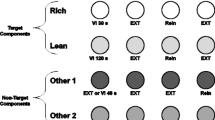Abstract
Previous research has demonstrated that rats’ rates of lever pressing for 1% liquid-sucrose reinforcers in the first half of a 50-min session increase when food-pellet, rather than the same sucrose, reinforcement will be delivered in the second half of the session. The present study investigated whether this increase (i.e., induction) would be influenced by alterations to the response-reinforcer relationship in the second half of the session. Experiment 1 manipulated this relationship by delaying reinforcers in the second half of the session by 0.1, 1.0, or 10.0 s, in different conditions. Induction was little affected by the delays. Experiment 2 provided reinforcers in the second half of the session on a different schedule of reinforcement (fixed ratio, fixed interval, or differential reinforcement of low rates) across conditions. Induction was large when the fixed-ratio schedule was upcoming and small or absent when the differential-reinforcement-of-low-rates schedule was upcoming. These differences, however, covaried with differences in obtained reinforcement. Experiment 3 eliminated the response-reinforcer relationship in the second half of the session by, in some conditions, delivering reinforcers on a variable-time schedule. Doing so reduced the size of, but did not eliminate, the observed induction. The present results increase the generality of induction and suggest that both the type of upcoming reinforcer and the contingency that deliver that reinforcer can contribute to its appearance.
Similar content being viewed by others
References
BAUM, W. M. (1973). The correlation-based law of effect. Journal of the Experimental Analysis of Behavior, 20, 137–153.
CRESPI, L. P. (1942). Quantitative variation in incentive and performance in the white rat. American Journal of Psychology, 40, 467–517.
FERSTER, C. B., & SKINNER, B. F. (1957). Schedules of reinforcement. New York: Appleton-Century-Crofts.
FLAHERTY, C. F. (1996). Incentive relativity. New York: Cambridge University Press.
LUCAS, G. A., TIMBERLAKE, W., GAWLEY, D. J., & DREW, J. (1990). Anticipation of future food: Suppression and facilitation of saccharin intake depending on the delay and type of future food. Journal of Experimental Psychology: Animal Behavior Processes, 16, 169–177.
MCSWEENEY, F. K., & WEATHERLY, J. N. (1998). Habituation to the reinforcer may contribute to multiple-schedule behavioral contrast. Journal of the Experimental Analysis of Behavior, 69, 199–221.
MOWRER, O. H. (1960). Learning theory and behavior. New York: Wiley.
RICHARDS, R. W. (1972). Reinforcement delay: Some effects on behavioral contrast. Journal of the Experimental Analysis of Behavior, 17, 381–394.
RICHARDS, R. W. (1973). Stimulus generalization and delay of reinforcement during one component of a multiple schedule. Journal of the Experimental Analysis of Behavior, 19, 303–309.
SCHAAL, D. W., SHAHAN, T. A., KOVERA, C. A., & REILLY, M. P. (1998). Mechanisms underlying the effects of unsignaled delayed reinforcement on key pecking of pigeons under variable-interval schedules. Journal of the Experimental Analysis of Behavior, 69, 103–122.
SCHNEIDER, S. M. (1990). The role of contiguity in free-operant unsignaled delay of positive reinforcement: A brief review. The Psychological Record, 40, 239–257.
TIMBERLAKE, W., GAWLEY, D. J., & LUCAS, G. A. (1987). Time horizons in rats foraging for food in temporally separated patches. Journal of Experimental Psychology: Animal Behavior Processes, 13, 302–309.
WEATHERLY, J. N., DAVIS, C. S., & MELVILLE, C. L. (2000). Induction with upcoming food-pellet reinforcement. Learning and Motivation, 31, 180–199.
WEATHERLY, J. N., & MOULTON, P. L. (2001). The effect of food-pellet reinforcement on rats’ rates of lever pressing for 1% sucrose reinforcers across several “contrast” procedures. Learning and Motivation, 32, 193–218.
WEATHERLY, J. N., RUE, H. C., DAVIS, C. S., & MELVILLE, C. L. (2000). Delivering different reinforcers in each half of the session: Effect of reinforcement rate. The Psychological Record, 50, 543–556.
WEATHERLY, J. N., STOUT, J. E., DAVIS, C. S., & MELVILLE, C. L. (2001). For better or worse: Effect of upcoming reinforcer type on rats’ lever pressing for low-concentration sucrose reinforcers. The Psychological Record, 51, 629–644.
WEATHERLY, J. N., STOUT, J. E., MCMURRY, A. S., RUE, H. O., & MELVILLE, C. L. (1999). Within-session responding when different reinforcers are delivered in each half of the session. Behavioural Processes, 46, 227–243.
WEATHERLY, J. N., STOUT, J. E., RUE, H. C., & MELVILLE, C. L. (2000). The effect of second-half reinforcer type on responding for sucrose in the first half of the session. Behavioural Processes, 49, 43–60.
WILKIE, D. M. (1971). Delayed reinforcement in a multiple schedule. Journal of the Experimental Analysis of Behavior, 16, 233–239.
WILLIAMS, B. A. (1976). The effects of unsignalled delayed reinforcement. Journal of the Experimental Analysis of Behavior, 26, 441–449.
WILLIAMS, B. A. (1989). The effects of response contingency and reinforcement identity on response suppression by alternative reinforcement. Learning and Motivation, 20, 204–224.
Author information
Authors and Affiliations
Corresponding author
Additional information
Partial support for this research was provided to Jeffrey Weatherly by North Dakota EPSCoR, a subprogram of NSF.
Rights and permissions
About this article
Cite this article
Weatherly, J.N., Moulton, P.L. & Ritt, J.J. Rats’ Response Rates for 1 % Sucrose When Food-Pellet Reinforcement is Upcoming: Effect Of Upcoming Reinforcement Contingency. Psychol Rec 52, 221–240 (2002). https://doi.org/10.1007/BF03395425
Published:
Issue Date:
DOI: https://doi.org/10.1007/BF03395425




